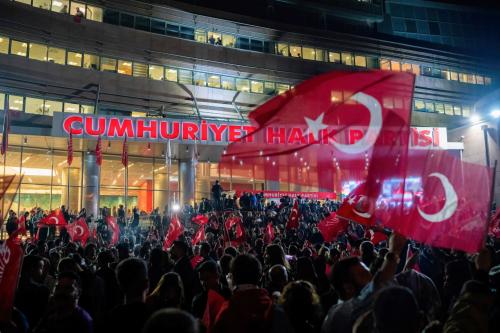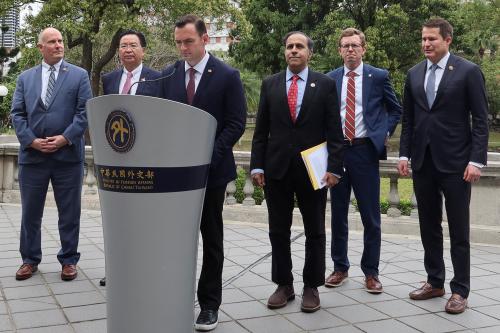They caught the attention of the world, not just their fellow countrymen, in June 2013, with street protests that first began on Istanbul’s Taksim Square and then spread throughout the country, but who exactly are Turkey’s protestors? Turkish polling agency KONDA took to the streets on June 6 and 7 in an attempt to answer that question. The results of KONDA’s poll reveal some striking similarities between Turkey’s protestors and Russians who turned out to protest against the falsification of electoral results after Russia’s December 2011 parliamentary elections.
Perhaps the most significant of a number of similarities between Russian and Turkish protestors is their abnormally high level of educational attainment. Russia’s top independent polling agency, the Levada Center, discovered at a December 24, 2011, protest on Moscow’s Sakharov Prospect that 81 percent of the protestors at this particular demonstration had completed some form of tertiary education. KONDA found that the respective figure was 56 percent of the 4,411 Turkish protestors it polled in early June 2013. Both figures are much higher than the national rates of higher education in Russia and Turkey—with the Turkish figure especially jarring. As reported by the OECD in 2012, only 13 percent of Turks between the ages of 25-64 had completed tertiary education in contrast to at least 54 percent of Russians.
A cursory glance at the makeup of the Turkish protests also reveals a decidedly youthful group. KONDA’s poll put the average age at 28. As Brookings’s Kemal Kirisci has written, this group’s appearance on the country’s political stage may portend a major shift in Turkish democracy, in terms of expanding the age range of people who are actively interested and engaged in politics. This shift has already occurred in Russia (which has a much smaller youth cohort in its overall population than Turkey). The Levada Center reported that 55 percent of the Russian protestors were between the ages of 18 and 39 (Levada did not calculate the average age of the Russian protestors they polled).
The youthful profile of the Turkish and Russian protestors is reflected in their use of new technologies. In a question that permitted multiple responses, 56 percent of those polled on December 24, 2011, by Russia’s Levada Center said they had learned of the protest through “internet publications” and 33 percent had learned of them through “other internet sources.” When posed a more specific question, 68 percent of Russian protestors stated they had read about the December parliamentary election falsifications on blogs. Turkey’s Taksim Square protestors proved even more tech and media savvy. “Social media” was cited by 69 percent of respondents in the KONDA poll as their primary source of information about the protests. Another 8 percent said they had heard of them through “the Internet.”
Turkish and Russian protestors have much in common, but there are also some notable differences. Turkish protestors are decidedly less politically engaged and organized than their Russian counterparts. Eighty five percent of Russian protestors said they had voted in the December 2011 parliamentary elections that triggered their protests. In contrast, in the KONDA poll, when asked if they planned to vote in Turkey’s 2014 local and presidential elections, 37 percent of Turkish protestors said they had actually never voted in an election. A further 18 percent said that they did not intend to vote. Forty seven percent of those polled also expressed the view that there was “no party to vote for.” Russians, on the other hand, had very specific party choices in the 2011 parliamentary elections and equally clear preferences for candidates the 2012 Russian presidential elections. They knew who they would vote for if all prospective candidates and political parties were allowed on the Russian electoral ballot.
In spite of these differences, a strong sense of disenfranchisement was the major impetus for the protests in both Russia and Turkey. Politically-sophisticated and well-educated Russians were furious to find that the Russian authorities discounted their electoral choices once the December 2011 ballot was completed––in a series of blatant acts they were able to watch on YouTube. They took away the clear message that their government did not consider them smart or wise enough to elect Russia’s leaders. All important decisions would be made at the top, irrespective of Russian citizens’ electorally-expressed wishes. The population should essentially accept the outcome and “shut up.” Russian protestors declared “We are not cattle! We are the Russian people!” in response.
In Turkey, young protestors feel disenfranchised, without representation and alienated from political participation; as indicated in KONDA’s polling, nearly half felt that there was no political party to vote for. The protests were not triggered by an election or a particular political ideology, but by another high-level decision that disregarded popular sentiment––the Turkish authorities’ dismissive and violent treatment of peaceful activists calling for the reversal of a decision to develop a public park in Istanbul. Turkish Prime Minister Recep Tayyip Erdogan was instrumental in this decision, which came on the heels of a series of policy pronouncements that convinced Turkish protestors the authorities gave no consideration to their views and preferences (irrespective of whether they voted or not).
In the past year, Prime Minister Erdogan has variously issued edicts against wearing red lipstick, promoted warnings to couples kissing in public, announced new regulations on the sale of alcohol, and made pronouncements on the number of children a Turkish woman should have (three). Since the protests, Erdogan has also spoken out against the use of Twitter. Russia’s President Vladimir Putin has made similar admonitions against Twitter and other social media, and has also exhorted Russian women to bear three children. Regulations on alcohol have been less severe and Russia is still open for red lipstick and kissing in public. Nonetheless, in both Russia and Turkey, the top leaders act as though their countrymen and women are incapable of making their own informed decisions. Young, educated, tech-savvy, and cosmopolitan Russians and Turks are increasingly insulted by their governments’ paternalism.


Commentary
We Are Not Cattle: Protestors in Turkey and Russia
June 24, 2013